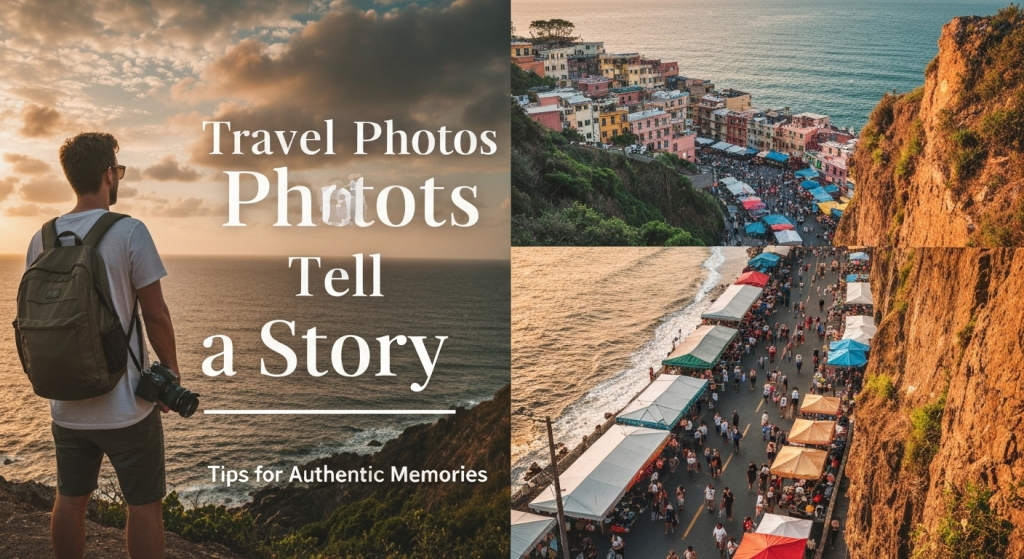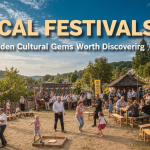Travel photography changed my life five years ago when I first picked up a camera during a backpacking trip through Southeast Asia. What started as random snapshots became a passion that transformed how I see the world. I’m Mahnoor Farooq, and over the past five years, I’ve traveled to over 30 countries, capturing stories through my lens while working as a professional travel photographer and content creator.
The difference between a snapshot and a story lies in intention. Every photo should answer the question: what story am I telling? This guide will teach you how to create travel photos that transport viewers to your exact moment and feeling.
What Makes Travel Photos Tell Stories
Story-driven travel photography goes beyond documenting where you went. It captures emotions, connections, and moments that make people feel like they were there with you. The best travel photos make viewers ask questions: Who lives in that colorful house? What does that street food taste like? What happened right before this moment?
During my first trip to Morocco, I learned this lesson the hard way. My early photos showed beautiful architecture and landscapes, but they felt empty. They looked like postcards instead of personal memories. Everything changed when I started focusing on people, interactions, and small details that revealed the heart of each place.
Key Elements of Story-Driven Travel Photos:
- Human connection and emotion
- Cultural context and local life
- Environmental details that set the scene
- Authentic moments instead of posed shots
- Personal perspective and unique viewpoint
Planning Your Story Before You Travel
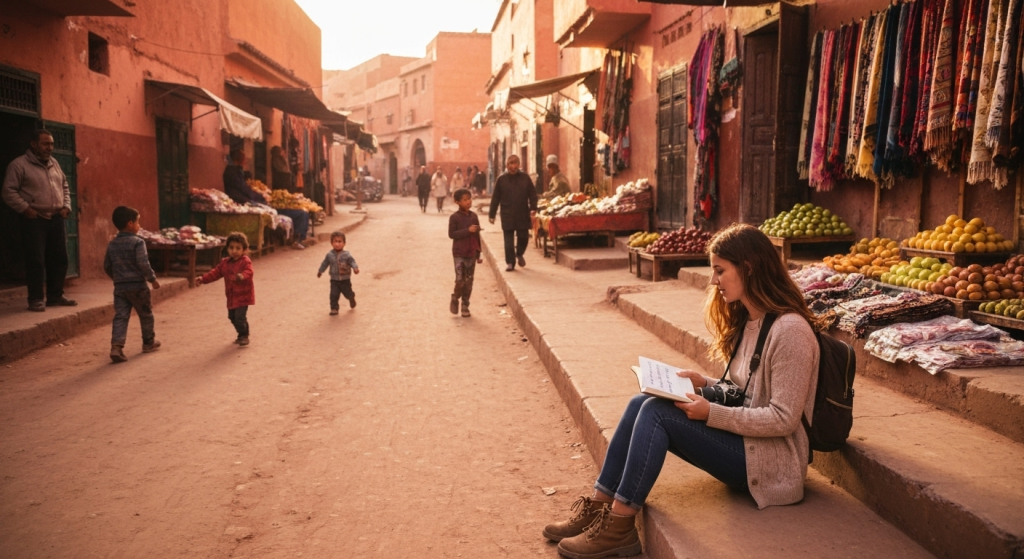
Smart travel photographers start crafting their story before leaving home. Research plays a crucial role in understanding what makes each destination unique. I spend hours studying local customs, festivals, daily routines, and hidden gems that most tourists miss.
Create a shot list that includes different types of stories you want to tell. Think about the morning routines of locals, traditional crafts being made, children playing in streets, or elderly people sharing wisdom. These human elements create the strongest emotional connections.
Pre-Travel Planning Checklist:
- Research local customs and daily life
- Identify unique cultural elements
- Plan for different times of day
- Connect with local photographers online
- Learn basic phrases in the local language
Essential Camera Settings for Travel Stories
Technical skills matter, but they shouldn’t overwhelm creativity. I use simple camera settings that let me focus on moments instead of buttons and dials. Most of my storytelling photos use aperture priority mode with settings that keep the subject sharp while creating context.
For street photography and candid moments, I keep my ISO between 400-1600 depending on light conditions. This lets me shoot handheld without blur while maintaining image quality. My aperture usually stays between f/2.8 and f/5.6, creating enough depth to show context without losing subject focus.
| Setting Type | Recommended Range | Purpose |
|---|---|---|
| Aperture | f/2.8 – f/5.6 | Subject focus with context |
| ISO | 400 – 1600 | Handheld shooting flexibility |
| Shutter Speed | 1/125s or faster | Prevent motion blur |
| Focus Mode | Single-point AF | Precise subject selection |
Burst mode becomes your best friend for capturing authentic expressions and interactions. People’s faces change constantly during conversations, and burst mode helps you catch the perfect moment of laughter, surprise, or contemplation.
Composition Techniques That Create Narrative
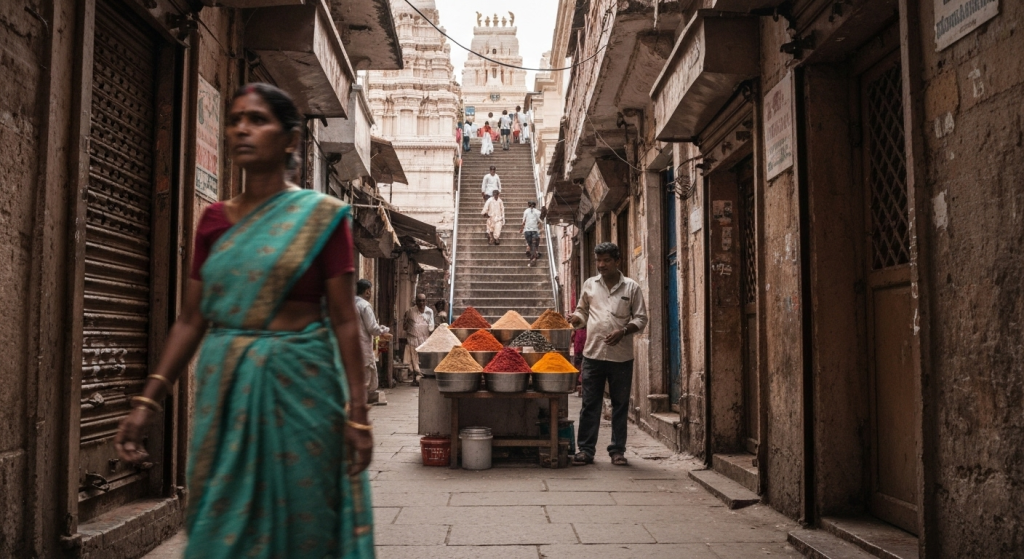
Strong composition guides viewers through your story. The rule of thirds works well, but breaking it intentionally can create more dramatic impact. I often place my main subject off-center to include environmental elements that add context and depth.
Leading lines help viewers understand the journey or movement in your photo. Roads, rivers, building edges, or even people’s gazes can guide attention toward your main story element. During my time photographing in India, I discovered how powerful staircases, doorways, and market aisles became in creating visual pathways.
Foreground, middle ground, and background layers add depth that makes photos feel three-dimensional. A flower in the foreground, people in the middle ground, and mountains in the background create layers that viewers can explore. Each layer should contribute to your overall story.
Composition Tools for Storytelling:
- Use frames within frames (doorways, windows, arches)
- Include hands, feet, or partial figures for human scale
- Show cause and effect relationships
- Create visual triangles with three story elements
- Use color contrasts to highlight important details
Capturing Authentic Cultural Moments
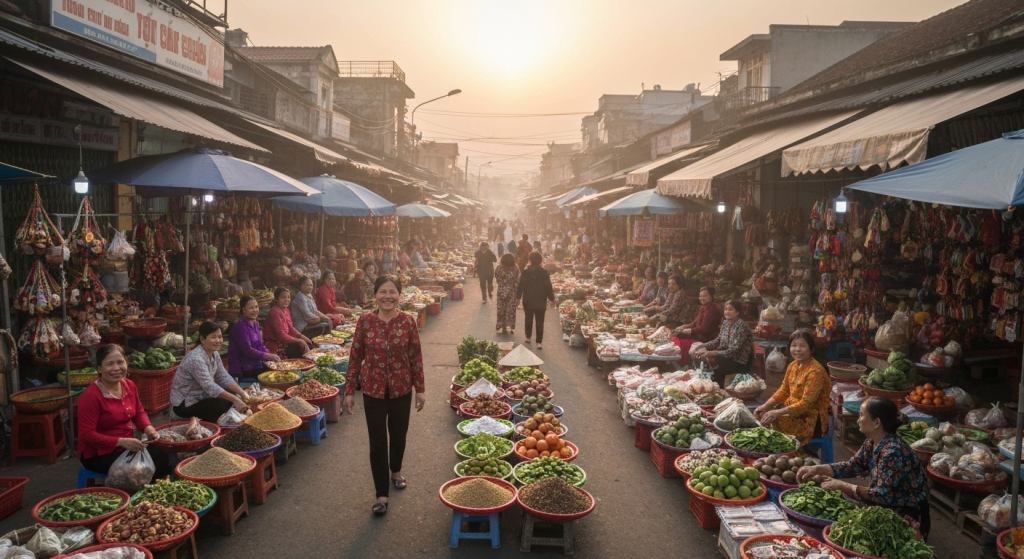
Authentic moments happen when people forget about your camera. This takes patience, respect, and genuine interest in local culture. I spend time in communities before taking photos, learning names, sharing meals, and understanding daily routines.
Market scenes offer incredible storytelling opportunities. The interaction between vendors and customers, the careful selection of produce, the negotiation process, and the satisfaction of a completed transaction all tell universal human stories. These moments happen quickly, so positioning yourself in the right spot requires observation and anticipation.
Children playing provide natural storytelling material because they’re less camera-conscious than adults. Their games, expressions, and interactions with each other reveal cultural values and social dynamics. Always ask parents for permission and respect local customs about photographing children.
Tips for Authentic Capture:
- Spend time without your camera first
- Learn basic greetings in local languages
- Show interest in people’s work and lives
- Share photos on your camera’s LCD screen
- Respect religious and cultural sensitivities
Working with Natural Light Throughout the Day
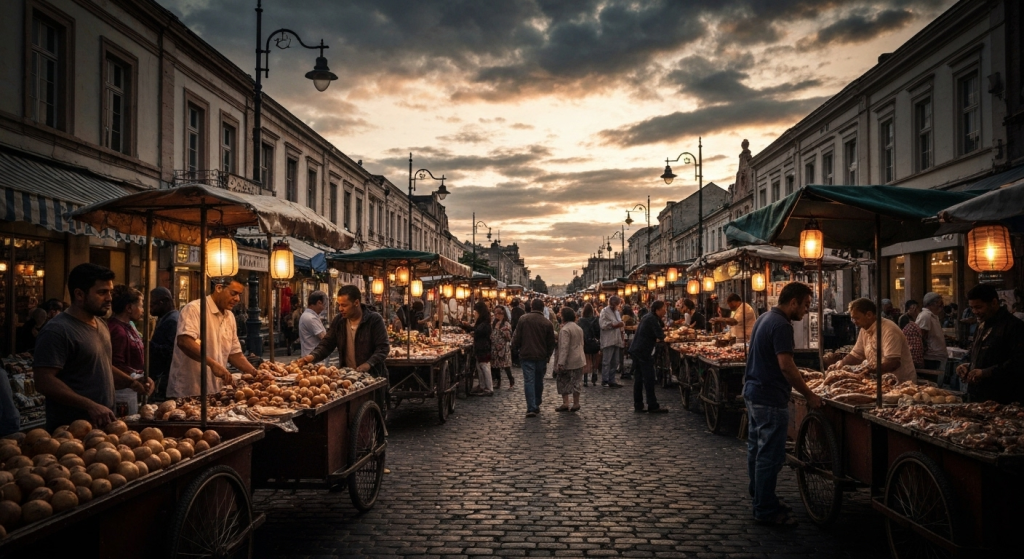
Light shapes the mood and emotion in your travel stories. Golden hour provides warm, flattering light that makes everything look magical, but every time of day offers unique storytelling opportunities. Harsh midday sun creates dramatic shadows and strong contrasts that can emphasize cultural elements.
Blue hour, just after sunset, creates moody atmospheric conditions perfect for street scenes with artificial lighting. The balance between remaining daylight and street lights, neon signs, or market stalls creates compelling visual stories about nightlife and evening routines.
Overcast conditions work beautifully for portraits and intimate cultural moments. The soft, even light eliminates harsh shadows and allows people’s expressions to shine. Some of my most emotional travel photos were taken during cloudy days when light felt gentle and embracing.
| Time of Day | Light Quality | Best Story Types |
|---|---|---|
| Golden Hour | Warm, soft | Portraits, landscapes, daily life |
| Blue Hour | Moody, atmospheric | Street scenes, nightlife |
| Midday | Harsh, contrasty | Architecture, dramatic shadows |
| Overcast | Soft, even | Intimate moments, portraits |
Building Photo Series That Flow Together
Individual photos tell moments, but photo series tell complete stories. Think of your travel photography as chapters in a book, with each image contributing to a larger narrative about place, culture, or experience. Consistent editing style helps unify diverse images into cohesive stories.
I organize my photo series around themes like “Morning Routines,” “Traditional Crafts,” or “Community Gatherings.” Each series includes establishing shots that show location and context, medium shots that focus on interactions, and close-ups that capture emotions and details.
Color palettes help create visual consistency across different locations and subjects. During my documentation of traditional crafts across Central America, I focused on earth tones, natural textures, and warm lighting that unified pottery makers, textile weavers, and wood carvers into one cohesive story.
Series Planning Elements:
- Wide shots for context and location
- Medium shots for interactions and activities
- Close-ups for emotions and details
- Consistent color grading and editing style
- Logical sequence that builds narrative tension
Post-Processing for Story Enhancement
Post-processing should enhance your story without overwhelming it. I use editing to guide viewers’ attention toward important story elements and create emotional consistency across image series. Heavy-handed editing often destroys the authentic feeling that makes travel photos compelling.
Color grading helps establish mood and atmosphere. Warmer tones create feelings of comfort, tradition, and human connection. Cooler tones suggest distance, modernization, or melancholy. The key is matching your color choices to the emotional story you want to tell.
Contrast adjustments help separate your main subject from backgrounds while maintaining natural-looking results. I often darken backgrounds slightly and brighten faces or hands to draw attention to human elements without making edits obvious.
Essential Editing Adjustments:
- Exposure correction for proper brightness
- Highlight/shadow recovery for detail retention
- Subtle color grading for mood enhancement
- Contrast adjustments for subject separation
- Sharpening for crucial story details
Common Mistakes That Weaken Your Stories
Over-planning kills spontaneity and authentic moments. While preparation helps, the best travel stories happen when you remain open to unexpected opportunities. Some of my strongest images came from completely unplanned encounters and situations.
Tourist trap photography creates images everyone has already seen. The challenge lies in finding fresh perspectives on popular destinations or discovering overlooked details that reveal new stories. Even in heavily photographed places, patient observation reveals unique moments and angles.
Ignoring local customs and boundaries damages both your photos and relationships with communities. Understanding cultural sensitivities, asking permission appropriately, and respecting “no photography” requests builds trust that leads to better access and more authentic images.
Mistakes to Avoid:
- Shooting only famous landmarks
- Ignoring cultural photography etiquette
- Over-editing until photos look artificial
- Focusing on equipment instead of moments
- Rushing through locations without observation
Equipment That Supports Storytelling
Camera choice matters less than understanding light, composition, and human behavior. I’ve created compelling travel stories with everything from professional DSLRs to smartphone cameras. The key is choosing equipment that doesn’t interfere with natural interactions and moment capture.
Prime lenses force creative thinking and often produce more intimate results than zoom lenses. A 35mm or 50mm lens encourages you to get closer to subjects and become part of the scene instead of photographing from a distance. This proximity often leads to better relationships with subjects and more authentic expressions.
Lightweight gear enables longer shooting days and less intrusive photography. Heavy camera systems create barriers between you and local communities while causing fatigue that affects creative decision-making. I prioritize mobility and discretion over maximum technical capabilities.
| Equipment Type | Recommended Options | Storytelling Benefits |
|---|---|---|
| Camera Body | Mirrorless or compact DSLR | Lightweight, less intimidating |
| Primary Lens | 35mm or 50mm prime | Forces proximity, natural perspective |
| Backup Option | Smartphone with good camera | Always available, very discrete |
| Support | Lightweight tripod | Stable shots in low light |
Building Connections for Better Access
Authentic travel photography requires genuine human connections. People can sense when photographers care only about getting images versus understanding their lives and culture. I invest time in learning local customs, trying regional foods, and participating in community activities before bringing out my camera.
Social media and local photography communities provide valuable connections before and during travel. Reaching out to local photographers, cultural organizations, or community leaders often opens doors to experiences and access that independent travelers rarely discover.
Language learning, even basic phrases, demonstrates respect and opens communication channels. Simple greetings, “please,” “thank you,” and “may I take your photo?” in local languages show effort and consideration that people appreciate. These small gestures often lead to incredible photographic opportunities.
Frequently Asked Questions
How do I approach strangers for street photography without being intrusive?
Start by observing without your camera, smile and make eye contact, then ask permission through gestures or basic local phrases. Share photos on your camera’s LCD screen and show genuine interest in their responses. Respect “no” answers immediately and gracefully.
What’s the best way to photograph children during travel?
Always ask parents or guardians for permission first, understand local customs about child photography, focus on activities rather than posed portraits, and consider sharing prints or digital copies with families. Respect cultural and religious sensitivities that may restrict child photography.
How can I create compelling photos in heavily touristed locations?
Visit during off-peak hours, focus on details others miss, photograph local workers and residents instead of tourists, find elevated or unusual angles, and look for reflections, shadows, or weather conditions that create unique perspectives on familiar scenes.
Should I edit my travel photos heavily to make them more dramatic?
Maintain authenticity while enhancing natural beauty through subtle adjustments. Focus on exposure correction, gentle color grading, and contrast improvements that support your story. Heavy editing often destroys the genuine feeling that makes travel photography compelling and trustworthy.
Creating Lasting Memory Collections
Travel photography becomes more meaningful when images connect to create comprehensive story collections. I organize my work into themed albums that capture different aspects of cultural experiences: daily routines, celebrations, traditional crafts, local food culture, and generational relationships.
Physical photo books provide tangible ways to share travel stories with others and preserve memories for future reflection. Digital galleries work well for immediate sharing, but printed collections create lasting artifacts that maintain emotional impact over time. The process of selecting and sequencing images for books forces you to evaluate which photos truly contribute to your story.
Regular review and curation improve both current and future photography. Analyzing successful images helps identify patterns in composition, timing, and subject selection that work well for your storytelling style. Understanding why certain photos create strong emotional responses guides better decision-making during future travels.
Your travel photos should transport viewers to places they’ve never been while helping you relive experiences with full emotional intensity. When images accomplish both goals, they become valuable cultural documents and personal treasures that grow more meaningful over time.
The journey from snapshot to story requires patience, cultural sensitivity, and genuine curiosity about human experiences. Technical skills support creative vision, but authentic connections with people and places create the foundation for compelling travel photography. Start with one destination, focus on understanding rather than just documenting, and let your unique perspective guide the stories you choose to tell.

